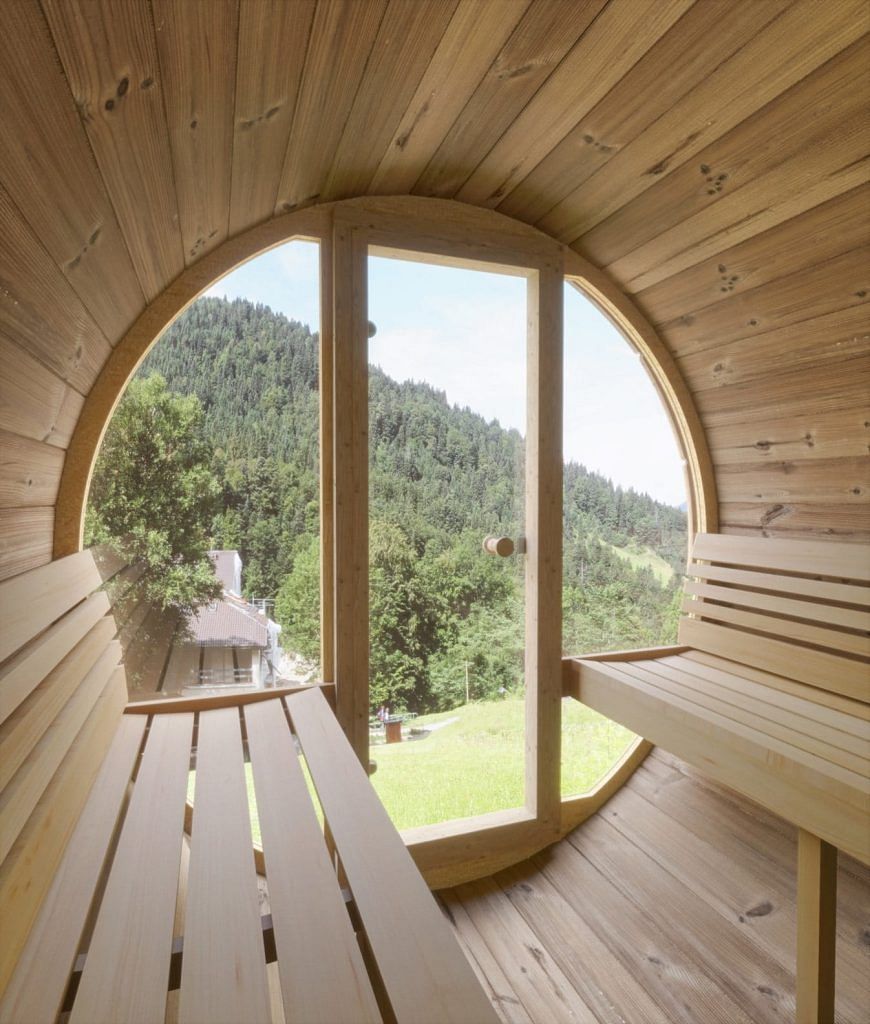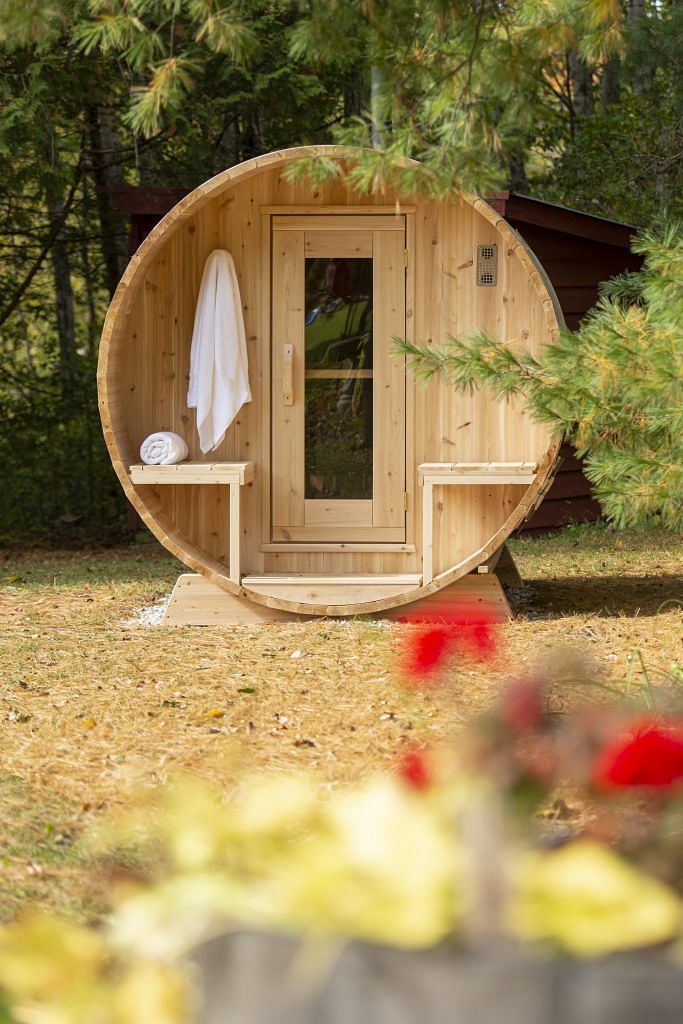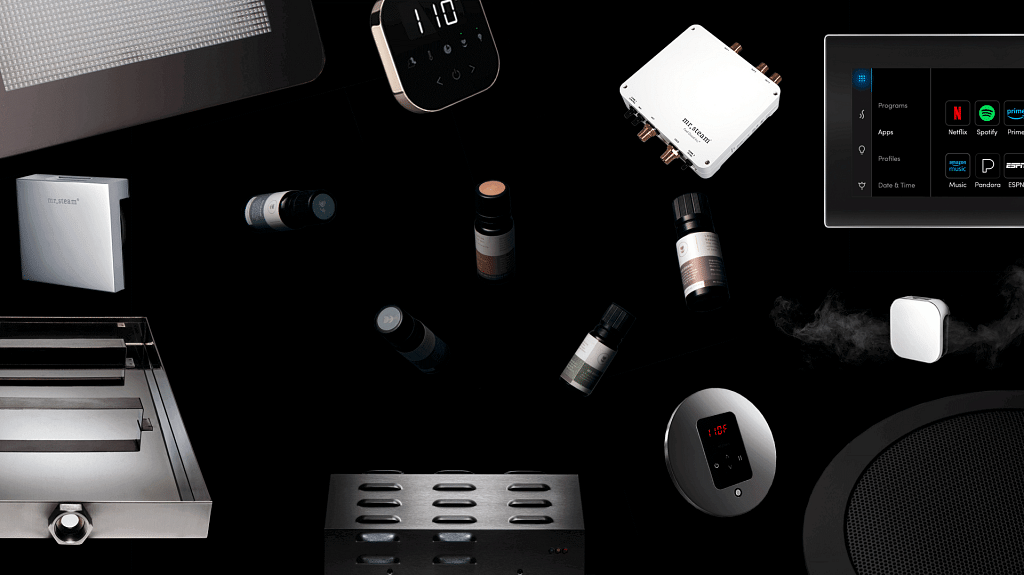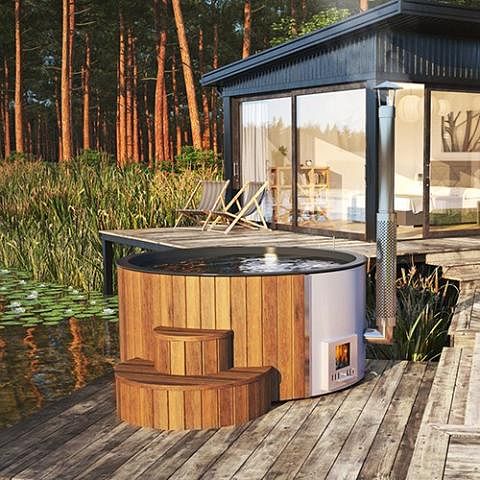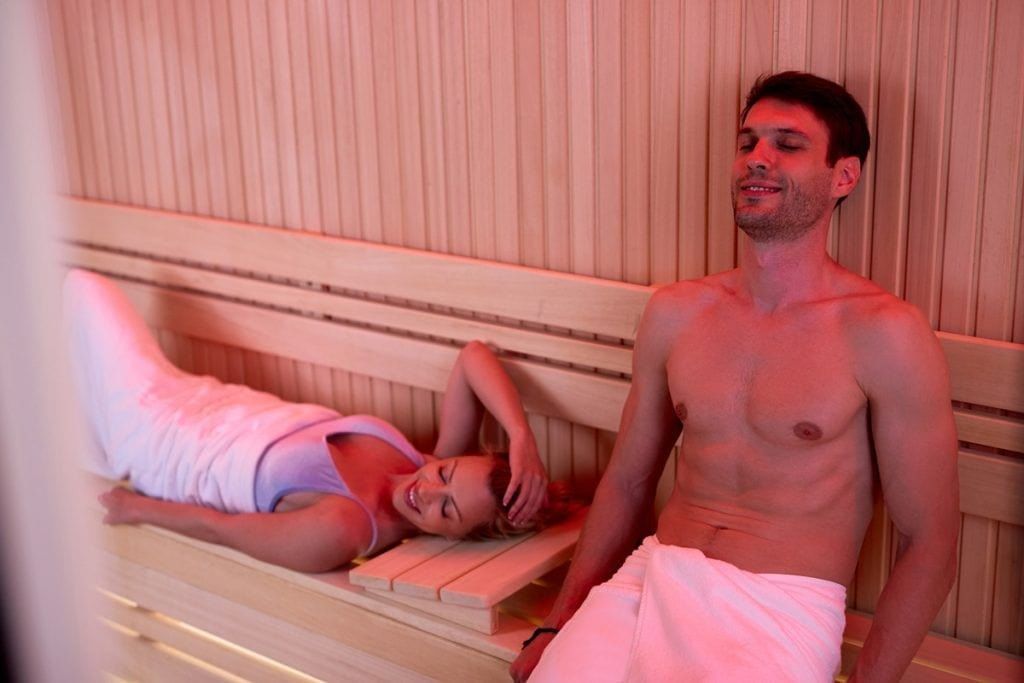Sauna
Near vs Far Infrared Saunas: Which One Should You Choose?
Near vs Far Infrared Saunas: Which One Should You Choose?
Choosing an infrared sauna isn’t as simple as picking the first option you find. The terms near infrared and far infrared sound similar, but they deliver heat and health benefits in very different ways. Pick the wrong one, and you might miss out on the results you’re looking for, whether that’s pain relief, detox, or deep relaxation.
In this guide, we’ll break down the science behind both types, compare their benefits, and help you decide which infrared sauna best fits your goals, lifestyle, and budget.
What Is an Infrared Sauna?
Unlike traditional saunas that heat the air around you using hot rocks or steam, infrared saunas differ significantly in how they deliver heat and benefits. Think of it like standing in warm sunlight.
You feel the heat penetrating your skin even if the air temperature remains cool. This direct heating method allows infrared saunas to operate at much lower temperatures (usually between 120-140°F) compared to traditional saunas (180-200°F). This makes the experience more comfortable while still delivering therapeutic benefits.
This is an excellent full-spectrum infrared sauna brand from Finnmark Designs:
Infrared radiation is simply light energy that we can’t see but can feel as heat. When these invisible light waves hit your body, they cause your molecules to vibrate, generating heat from within your tissues.
This process allows for deeper tissue warming and more efficient sweating at lower ambient temperatures. A key advantage of infrared saunas is that they appeal to people who find traditional saunas uncomfortably hot.
Understanding the Infrared Spectrum
To understand the differences between near and far infrared saunas, it’s essential to grasp where infrared light fits in the electromagnetic spectrum.
Infrared radiation occupies the space between visible light and microwave radiation, with wavelengths spanning from about 700 nanometers to 1 millimeter.
Within this range, scientists divide infrared into three categories:
- Near infrared (NIR),
- Mid infrared (MIR), and
- Far infrared (FIR).
Each category has different wavelengths and, consequently, different properties and therapeutic applications. Saunas focus on near and far infrared because these wavelengths offer the most health benefits and can be generated by current technology.
Now, let’s discuss both wavelengths briefly:
Near Infrared (NIR):
Near infrared light sits closest to visible red light on the electromagnetic spectrum. These shorter wavelengths have high energy and can penetrate approximately 1-2 inches (0.7 – 1.4 micrometers) into your body, primarily affecting the skin’s surface layers, subcutaneous tissue, and shallow muscle groups. This penetration depth makes NIR particularly effective for skin health, wound healing, and cellular energy production.
The high energy of near-infrared waves means they can stimulate cellular processes more directly. When NIR light hits your mitochondria (the powerhouses of your cells), it can increase ATP (adenosine triphosphate) production, essentially giving your cells more energy to repair and function optimally. This mechanism explains why NIR therapy often produces faster, more noticeable results for surface-level conditions.
Far Infrared (FIR)
Far infrared wavelengths are much longer and carry less energy per photon, but they can penetrate much deeper into your body – up to 4 inches beneath the skin. This deeper penetration allows FIR to warm your core body temperature, muscles, joints, and internal organs more effectively. The longer wavelengths resonate with water molecules in your body, creating gentle warming from the inside out.
This deep-heating characteristic makes far infrared most valuable for systemic benefits like detoxification, circulation improvement, and pain relief in deeper tissues. While NIR works more at the cellular level, FIR creates whole-body physiological responses that can impact your cardiovascular system, lymphatic drainage, and overall metabolic processes.
To get the most out of your sessions, it’s essential to know how to prepare for an infrared sauna before, during, and after use.
What Is a Near Infrared Sauna?
Near infrared saunas use specialized infrared heating lamps or LED panels that emit light in the 700-1400 nanometer range. These devices often incorporate red and near-infrared LEDs arranged in panels that you position around your body during treatment. Some systems use incandescent infrared bulbs that produce both visible red light and near infrared radiation. This is how it looks:
The beauty of near-infrared saunas lies in their targeted approach. Rather than heating an entire enclosed space, many NIR systems allow you to focus the light on specific body areas. You might position panels to target your face for skin benefits, your back for muscle recovery, or your joints for localized healing. This targeted approach allows you to address specific health concerns while avoiding the full-body heat stress that some people find challenging, as well as skincare concerns.
Health Benefits of Near Infrared
Near infrared therapy has gained high momentum attention in the wellness community for its rapid, visible results, particularly for skin health and surface-level healing.
The shorter wavelengths can stimulate collagen production, leading to improved skin texture, reduced fine lines, and a more youthful appearance. This user (jordang95) confirmed the skin benefits of NIR light:
Beyond cosmetic benefits, near infrared excels at wound healing and tissue repair. The light stimulates cellular metabolism, increases blood flow to treated areas, and can reduce inflammation.
Athletes often use NIR therapy to speed recovery from muscle strains, cuts, or bruises. Some studies suggest that regular NIR exposure can even help with seasonal affective disorder by providing light therapy benefits similar to specialized SAD lamps.
The mitochondrial stimulation provided by near infrared is perhaps its most fundamental benefit. By improving cellular energy production, NIR can improve overall vitality and may help combat the cellular aging process.
What Is a Far Infrared Sauna?
Far infrared saunas operate on the principle of deep-penetrating heat that warms your body from the inside out. The heating elements, usually ceramic or carbon panels, emit long-wavelength infrared radiation that passes through the air without heating it. Instead, this energy is absorbed by your body and creates a gentle warming sensation that builds gradually.
This heating method explains why FIR saunas can operate at lower air temperatures while still producing substantial sweating. Your core body temperature rises as the far infrared energy penetrates deeply into your tissues, triggering your body’s natural cooling response through perspiration. The process feels more like a gentle warming from within rather than the intense external heat of traditional saunas.
Health Benefits of Far Infrared
Far infrared saunas are well known for supporting the body’s natural detox process. The deep-penetrating heat induces sweating, which some proponents believe helps eliminate toxins through the skin. While the scientific consensus on “detox” varies, the sweating response certainly helps with electrolyte balance and may support the body’s natural elimination processes.
Maxxus 3-Person Full Spectrum Near Zero EMF (Under 2MG) FAR Infrared Sauna (Canadian Red Cedar)
Joint and muscle pain relief represents another FIR benefit. The deep heating can improve circulation to affected areas, reduce inflammation, and provide temporary pain relief for conditions like arthritis, fibromyalgia, and chronic back pain. Many users find that regular FIR sauna sessions help manage chronic pain conditions more effectively than surface-level heat treatments.
It has cardiovascular benefits, too. Regular use can improve circulation, potentially lower blood pressure, and provide a passive cardiovascular workout similar to moderate exercise. Some studies suggest that consistent FIR sauna use may improve endothelial function and reduce the risk of cardiovascular events, though more research is needed to confirm these effects.
Near Infrared vs Far Infrared: Head-to-Head Comparison
1. Penetration Depth and Target Tissues
The fundamental difference between near and far infrared lies in how deeply each penetrates your body and which tissues it primarily affects. Near infrared’s 1-2 inch penetration depth makes it ideal for skin conditions, superficial muscle issues, and localized healing. If you’re dealing with acne, wrinkles, minor cuts, or surface-level muscle tension, NIR’s shallow but intense penetration delivers targeted results.
Far infrared’s deeper 3-4 inch penetration reaches into your core, affecting internal organs, deep muscle groups, and your overall circulation system. This makes FIR more suitable for systemic issues like chronic pain, cardiovascular concerns, or when you’re seeking whole-body detoxification benefits.
The choice often comes down to whether you need surface-level treatment or deeper, systemic therapy.
For a deeper comparison between near and far infrared options, check out our detailed guide here.
2. Sauna Heat Sensation and Comfort
The experience of using near versus far infrared saunas differs in terms of heat sensation and comfort. Near infrared systems often provide a more intense, localized warming sensation. You might feel the heat intensely where the light hits your skin, but areas not directly exposed remain cooler. This can be advantageous for targeted therapy but may feel uneven for those seeking whole-body warming.
Golden Designs Maxxus “Seattle” Edition 2-Person Near Zero EMF FAR Infrared Carbon Sauna
Far infrared saunas, on the other hand, create a more gentle, enveloping warmth that builds gradually throughout your body. Many users describe FIR heat as more comfortable and relaxing, similar to lying in warm sunlight. The even heat distribution makes FIR saunas more suitable for people who are heat-sensitive or new to sauna therapy.
3. Sauna Session Duration and Use Cases
Session lengths vary between the two types, too. Near infrared sessions often last 15-30 minutes due to the more intense, localized heat. The targeted nature of NIR therapy also means you might use shorter sessions more frequently throughout the day, focusing on specific areas as needed.
On the other hand, far infrared sessions commonly last 30-45 minutes, allowing time for your core body temperature to rise and trigger substantial sweating. The gentler heat makes longer sessions more comfortable, which makes FIR saunas better suited for people who enjoy longer, more meditative relaxation sessions.
4. Types of Conditions Treated
Near infrared therapy excels for conditions requiring cellular stimulation and surface-level healing. Skin rejuvenation, wound healing, seasonal affective disorder, minor muscle strains, and localized inflammation respond well to NIR treatment. Athletes often use NIR for quick recovery from minor injuries or to improve performance through improved cellular energy production.
Far infrared therapy shines for chronic conditions requiring deeper, systemic intervention. Arthritis, fibromyalgia, chronic fatigue, cardiovascular issues, and general detoxification goals align well with FIR benefits. People seeking stress relief, improved sleep, or overall wellness often prefer the comprehensive, whole-body approach of far infrared saunas.
5. Costs
Near infrared systems generally cost less upfront, especially portable LED panel systems that can range from $200-$2,000. These are popular for home use, offering flexibility and convenience without the need for a full sauna enclosure. Fixed NIR installations might cost $2,000-$8,000, depending on size and features.
Keep in mind that infrared sauna installations may have specific electrical requirements, particularly for full-size or cabin-style units.
What About Full-Spectrum Infrared Saunas?
Full-spectrum infrared saunas provide the best of all worlds by incorporating heating elements that emit near, mid, and far infrared wavelengths simultaneously. These systems use a combination of LED panels for near infrared and specialized heaters that produce the full infrared spectrum. The idea is to provide both the targeted, cellular benefits of near infrared and the deep, systemic benefits of far infrared in a single session.
Maxxus 2-Person Full Spectrum Near Zero EMF (Under 2MG) FAR Infrared Sauna
Mid infrared, which falls between near and far in the spectrum, penetrates approximately 2-3 inches into the body and is thought to improve circulation and reduce inflammation in ways that complement both NIR and FIR therapy. However, mid-infrared receives less attention in the research literature, and its specific benefits are less well-defined than those of near and far infrared.
Pros and Cons of Full-Spectrum Saunas
The primary advantage of full-spectrum saunas is versatility. You can potentially address surface-level skin concerns while simultaneously working on deeper issues like chronic pain or cardiovascular health. This comprehensive approach appeals to users who want maximum benefit from their sauna investment and don’t want to choose between different infrared types.
However, full-spectrum saunas come with increased complexity and cost. The multiple heating elements require more sophisticated control systems, and the combination of different infrared types may dilute the effectiveness of each spectrum. Some users find that focusing on their primary health goals with a dedicated near or far infrared system produces better results than the “jack of all trades” approach of full spectrum units.
Who benefits most from full-spectrum therapy?
People with multiple health concerns, those who want the flexibility to customize their sessions based on daily needs, and users who plan to share the sauna with family members who have different wellness goals often find full spectrum systems worthwhile.
Which Infrared Sauna Should You Choose?
Your health goals should drive your decision between near and far infrared saunas:
-
Are you primarily interested in skin rejuvenation, wound healing, or targeted muscle recovery? Near infrared’s precise, cellular-level benefits make it your best choice.
-
Are you dealing with chronic pain, seeking detoxification benefits, or wanting overall cardiovascular support? Far infrared’s deep-penetrating, systemic approach will serve you better.
Other factors to consider are:
1. Your budget:
Buying a sauna is like buying a car. After paying for the vehicle, you also need to consider fuel (electricity), maintenance (part replacements), and parking (space requirements). In the same way, buying an infrared sauna means considering not just the price tag, but also the ongoing costs and how the sauna fits into your home and lifestyle.
By looking at the total cost of ownership, not just the upfront price, you can make a smart investment that supports your health without straining your finances.
Near Infrared
If you’re working with a tighter budget or just getting started with infrared therapy, near infrared (NIR) systems are often the most accessible choice. These systems typically consist of portable LED panels or incandescent heat lamps, with prices ranging from $200 to $2,000 depending on quality and features.
But the benefits go beyond the lower price point:
- Energy-Efficient: NIR devices use relatively little electricity, making them cost-effective to run even with frequent use.
- Minimal Maintenance: With fewer mechanical components, there’s less that can go wrong. LED-based systems, in particular, have long lifespans and require little to no upkeep.
- No Construction Required: Most NIR setups are plug-and-play — just set them up in a small space (like a bathroom, closet, or home office) and you’re ready to go. There’s no need for special wiring, ventilation, or room remodeling.
- Portable and Space-Saving: NIR units are often compact and lightweight, so they’re perfect for people living in apartments, renters who can’t make permanent changes, or anyone who values the ability to move their setup around.
Overall, near infrared saunas are a great option if you’re looking for a lower-cost, low-commitment entry into infrared therapy. They’re handy for targeted relief — think localized muscle pain, skin health, or post-workout recovery — rather than full-body detox or deep tissue therapy.
Far Infrared
Far infrared (FIR) saunas come with a higher upfront cost. Still, they offer a full-body, spa-like experience that many users find well worth the investment — especially if you’re dealing with chronic health issues or want a more immersive approach to wellness.
A basic portable FIR sauna might start around $500 to $1,500, but traditional wooden cabin-style models — the kind you’d see in wellness centers or upscale homes — can range from $3,000 to over $10,000, depending on the size, wood type, heating technology, and added features like Bluetooth, chromotherapy, or built-in speakers.
But the investment doesn’t stop there:
- Higher Energy Use: Because FIR saunas heat the entire body and run for longer sessions, they tend to use more electricity than NIR setups. Expect a modest increase in your utility bill if you use it regularly.
- Installation Requirements: Larger cabin-style FIR saunas often require a dedicated room or corner in your home. Some models may need professional installation or upgrades to your electrical system.
- Maintenance and Upkeep: While FIR heaters are durable, they can wear out over time and may need replacing every few years. Wooden structures also require basic care to prevent moisture buildup or wear.
2. Space and Lifestyle Compatibility
Choosing the right infrared sauna isn’t just about what it does — it’s also about how well it fits into your daily life. Your living space, routine, and personal preferences all play a major role in determining which system will serve you best. Think of it like choosing between a treadmill and an elliptical: both can help you get fit, but one might work better with the space you have and how you prefer to exercise.
Near Infrared
Near infrared (NIR) therapy is a top choice for people with limited space, busy schedules, or a preference for portability. These systems are often small.
Here’s why NIR tends to work well with a variety of lifestyles:
- Fits in Small Spaces: Whether you’re in a city apartment, a dorm room, or a small home, NIR devices can be used almost anywhere.
- Portable and Flexible: Many NIR units are light enough to move from room to room. Some even fold up or come with carrying cases, making them easy to store when not in use or take with you when traveling.
- Quick Sessions, Easy Scheduling: NIR therapy sessions typically last 10–20 minutes, so it’s easy to work them into your morning or evening routine without rearranging your day.
- No Build-Out Required: Since you don’t need special ventilation, custom electrical work, or a dedicated room, NIR systems are perfect for renters or those not ready to commit to a permanent installation.
Far Infrared
Far infrared (FIR) saunas, on the other hand, are better suited to people who want a more immersive experience and have the space and routine to support it. These saunas are usually larger and are meant to be stationary, often taking up a dedicated corner or room in your home.
Here’s what to expect with FIR systems from a lifestyle and space perspective:
- Requires a Dedicated Space: Most full-size FIR saunas are large wooden enclosures, designed to stay in place. You’ll need to plan for placement, clearances, and potentially ventilation, depending on the model.
- Not Ideal for Frequent Moving: Unlike portable NIR devices, FIR saunas are heavy and generally not designed to be relocated once installed.
- Better for Long, Ritualized Use: FIR sessions often run 30–45 minutes, making them better suited for people who enjoy setting aside uninterrupted time to relax, meditate, or unwind.
- A Permanent Wellness Station: If you’re building a home gym, spa area, or wellness sanctuary, an FIR sauna can become a central feature — offering both visual appeal and daily health benefits.
In short, far infrared is ideal for people who want to create a dedicated space for deep relaxation and ongoing health management, and who are ready to make a longer-term commitment — in both space and routine — to their wellness practices.
Final Thoughts
The choice between near infrared, far infrared, and full spectrum saunas is about matching the right technology to your specific health goals and lifestyle needs.
Near infrared excels at targeted, cellular-level therapy that produces relatively quick results for skin health and localized healing. Far infrared provides deep, systemic benefits that support chronic conditions and overall wellness through comprehensive body warming. Full-spectrum systems offer versatility at the cost of complexity and higher investment.
Consider starting with the type that best addresses your primary health concern. You can always expand or modify your approach as you gain experience with infrared therapy and better understand how your body responds to different wavelengths. For all health matters, it is important to always contact your physician first.
Ready to purchase an infrared sauna? Check out our expert’s top picks here. Or, chat with any of our experts for a personalized recommendation.

